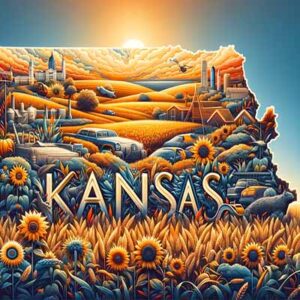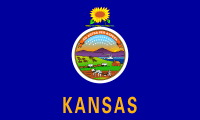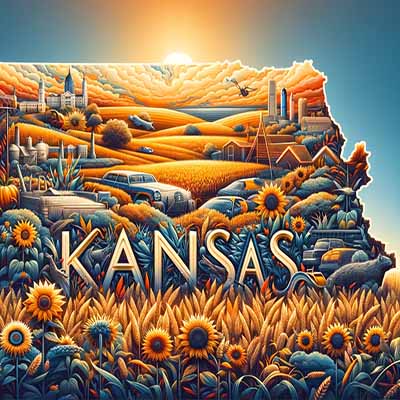Wichita & Kansas Statistics
Demographics – A Diverse and Expanding Population
Wichita, Kansas, renowned as the Air Capital of the World, stands as a pivotal city in the Midwest with a rich demographics and a well-defined urban structure. Spanning across the Arkansas River, Wichita’s unique geographical position enhances its cultural and economic significance in the state.

Wichita's Population Dynamics
With a population of 390,000+, Wichita is the largest city in Kansas. It is the 49th largest city in the United States. This bustling city showcases a diverse demographic spectrum, with a significant representation of various ethnic and cultural groups. Wichita’s population is characterized by a healthy mix of age groups, with a notable proportion of young professionals and families, indicating a growing community.
The city’s demographic diversity is not just a number; it’s reflected in the cultural festivals, diverse culinary scene, and the variety of community events taking place throughout the year. This diversity contributes to Wichita’s reputation as a welcoming and inclusive city.
Enjoy all the early historical facts about Wichita Kansas. Click the button and found out little know facts about this wonderful city, Wichita Kansas.
View all the current trends and historical weather facts about Wichita Kansas. You are only on click away from very little know knowledge about Wichita Kansas.
Kansas Facts

KANSAS Named for the Kansas or Kanza tribe of the Sioux family living along a river in the area and gave it the tribal name. The name translates as “south wind people,” or “wind people.”
WICHITA Wichita comes from the Wichita Indians, who settled at various times in the vicinity, and means either “scattered lodges” or “painted faces,” depending on which historian you ask. In 1868, a Wichita Town Company was organized with Mead and six others as original incorporators.
SEDGWICK COUNTY Sedgwick County was officially established nearly 150 years later on February 26, 1867, and bears the name of Civil War hero Major General John Sedgwick of the Union Army who was killed during the battle of Spottsylvania Courthouse in Virginia.
AREA (land) 81,815 sq miles (water) 459 sq miles (TOTAL) 82,274 sq miles
CAPITAL Topeka
FAMOUS DATES Organized as territory: May 30, 1854 Entered Union (rank): Jan. 29, 1861 (34) Present constitution adopted: 1859
LOCATION 37.6872° N, 97.3301° W
MEAN ELEVATION (average) 2,019 feet
HIGHEST POINT Mt. Sunflower; 4039 feet, 28th
LOWEST POINT Verdigris River; 680 feet, 43rd
COUNTIES 105
COASTLINE None
GEOGRAPHIC CENTER in Barton
STATE FOSSIL Tylosaurus and Pteranodon (Kansas has two official state fossils: Tylosaurus and Pteranodon, which are both known from Cretaceous-aged deposits in the western part of the state.)
STATE GRASS Little bluestem Schizachyrium scoparium
STATE REPTILE Ornate Box Turtle. The Ornate Box Turtle became the official State Reptile of Kansas in 1986 due to the efforts of the 6th-grade class at Caldwell Elementary led by their teacher, Larry L. Miller (Simmons 1986).
STATE ROCK Limestone. Limestone became the official state rock of Kansas in 2018. Ranchers once used limestone to build fence posts in Kansas, where wood supplies were limited. Limestone fence posts in Mitchell County, Kansas (June 1966).
STATE GEMSTONE Jelinite. In 2018 Kansas adopted a state mineral – Galena, and a state gemstone – Jelinite.
STATE FLAG The Kansas flag, adopted in 1925, consists of a dark blue field with the state seal in the center. A sunflower on a bar of twisted gold lies above the seal, and below the seal is the word Kansas.
STATE COLORS
STATE SEAL The seal contains a landscape including a rising sun, representing the east; and a river and steamboat, representing commerce. In the foreground, a settler’s cabin and a man plowing a field represent agriculture. A wagon train heads west and buffalo are seen fleeing from two Indians. Around the top of the seal is a cluster of 34 stars.
STATE SLOGAN First Of The Rectangle States
STATE MOTTO Ad astra per aspera (To the stars through difficulties)
STATE SONG “Home on the Range” (1947)
STATE TREE Cottonwood (1937)
STATE BIRD Western Meadowlark (1937)
STATE ANIMAL American Buffalo (or bison)
STATE FISH Channel Catfish
STATE METAL Galena
STATE NICKNAMES The Sunflower State, The Wheat State, Midway, U.S.A.
STATE FLOWER Sunflower (1903)
BORDERING STATES Colorado Missouri Nebraska Oklahoma
Geographic Layout and City Planning
Wichita covers an area of approximately 163 square miles, featuring a blend of urban and suburban landscapes. The city is renowned for its well-planned neighborhoods, each boasting distinct characteristics. Downtown Wichita, the heart of the city, has seen significant revitalization, becoming a bustling center for business, arts, and entertainment.
Suburban areas like Riverside and College Hill offer a more relaxed environment, with picturesque parks and historical landmarks. The careful urban planning of Wichita ensures a balance between growth and preservation, maintaining the city’s charm while adapting to modern needs.
Educational and Professional Scene in Wichita
Education plays a crucial role in Wichita’s community fabric. The city prides itself on a high literacy rate and a strong educational system, including Wichita State University, known for its innovation and research contributions. The presence of such institutions not only uplifts the educational standards but also contributes significantly to the local economy by creating a skilled workforce.
In terms of employment, Wichita’s economy is diverse, with strong sectors in manufacturing, healthcare, and education. The city is a hub for aviation manufacturing, hosting major companies like Spirit AeroSystems and Textron Aviation. This industrial diversity not only provides numerous job opportunities but also attracts professionals from various fields, adding to Wichita’s dynamic workforce.
Wichita's Economic Strength and Industrial Diversity
Wichita’s economic landscape is a testament to its resilience and adaptability. As a city associated with being an industrial powerhouse, it continues to diversify and strengthen its economic profile, adapting to modern challenges and opportunities.
The Economic Pillars of Wichita
Wichita’s economy has traditionally been anchored in manufacturing, especially aviation manufacturing, earning it the title of the Air Capital of the World. Major companies like Spirit AeroSystems and Textron Aviation drive this sector, making significant contributions to both local and national economies. Beyond aviation, Wichita also excels in healthcare, education, and technology, showcasing a diversified economic base.

